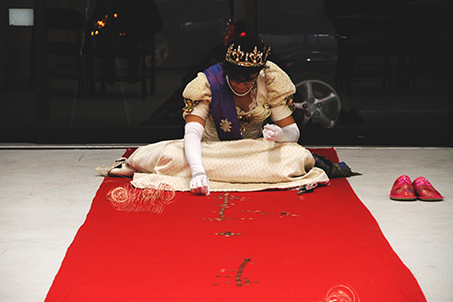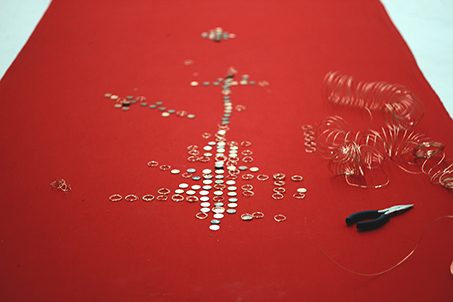The Queen's Punishment




The
sentence: 249 feet of copper wire; 154 pennies; 60 acts of retribution.
...
On March 29, 2012 it was announced that Canada would stop producing the 1¢ coin, commonly known as the penny. A symbol of sovereignty and colonial rule, the penny's place in Canadian national currency ensured the circulation of the Queen's profile in Canada's public sphere since her coronation in 1952. The year 2012 also marked another historic event: the Queen's Diamond Jubilee. What better way to mark the waning of a colonial symbol than the simultaneous pomp and pageantry of a $7.5 million celebration for the Queen in Canada?
As the symbols of nationalism begin to disappear from the public realm, what remains of those figures of colonial history in our present? What legacies do histories of colonialism leave as traces on the geographic and social landscape of contemporary nationalism?
...
On March 29, 2012 it was announced that Canada would stop producing the 1¢ coin, commonly known as the penny. A symbol of sovereignty and colonial rule, the penny's place in Canadian national currency ensured the circulation of the Queen's profile in Canada's public sphere since her coronation in 1952. The year 2012 also marked another historic event: the Queen's Diamond Jubilee. What better way to mark the waning of a colonial symbol than the simultaneous pomp and pageantry of a $7.5 million celebration for the Queen in Canada?
As the symbols of nationalism begin to disappear from the public realm, what remains of those figures of colonial history in our present? What legacies do histories of colonialism leave as traces on the geographic and social landscape of contemporary nationalism?
In this
first segment of a triptych on the penny and its chemical composition, Bamboat
uses performance to chart the history of the Canadian penny through the legacy
of British imperialism. Following
her own lineage through colonialism, Bamboat considers how the establishment of
British rule in Canada (1763) connects with the introduction of the 1¢ coin and
handing over of India to the British crown nearly a century later (1858). With
the rise and fall of the British Empire, Bamboat traces the residues of those
archaic forms of governance - those colonial nationalisms that persist in our
present. Matching the punishment to the crime, Bamboat sentences the Queen to a
laborious task of accounting for the penny's history in colonial rule.
To commemorate the punishment, the artist will be issuing limited edition commemorative postcards with 154 absolved pennies.
The Queen's Punishment took place part of the Feminst Art Gallery's (FAG) Satellite at Access Gallery August 24 – October 14, 2012.
A performance in 3 acts
2012
To commemorate the punishment, the artist will be issuing limited edition commemorative postcards with 154 absolved pennies.
The Queen's Punishment took place part of the Feminst Art Gallery's (FAG) Satellite at Access Gallery August 24 – October 14, 2012.
A performance in 3 acts
2012